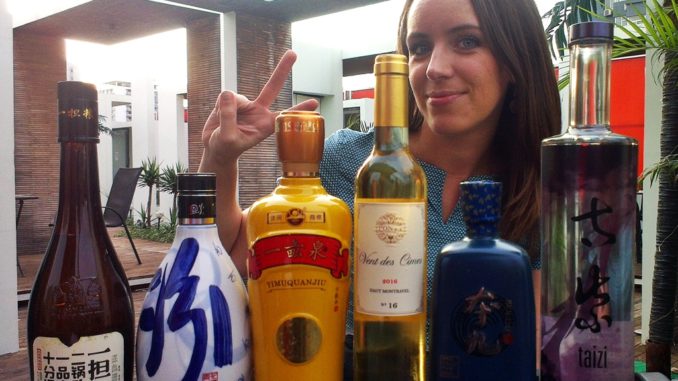
By Jim Boyce | Six years, sixty cities, thousands of ganbeis and a master’s degree worth of lessons. When it comes to planting a family wine brand in China, no one has the green thumb of Helene Ponty.
Ponty moved to Beijing in 2012, after diplomas in business at MIT and business law at Poitiers, and has since traversed the nation selling her family’s wine from Canon-Fronsac in Bordeaux.
We did a Q&A this week and, because she missed World Baijiu Day, an event I help organize, we also tasted a handful of spirits. See the China insights, baijiu notes, revelations and regrets below.

Destination Heihe
Boyce: Your most recent trip was to Heihe. Where is it? What was it like?
Ponty: Heihe means Black River and the buildings you see on the opposite bank are in Russia. My client said the population is 100,000, so I call it the northernmost city in China, although there is a village called Mohe even further north.
What was it like? I went two years ago for the first time. There were tons of Russian people coming to buy cheap Chinese stuff. But this time I saw a lot of Russian products being sold to people in Heihe due to currency changes.
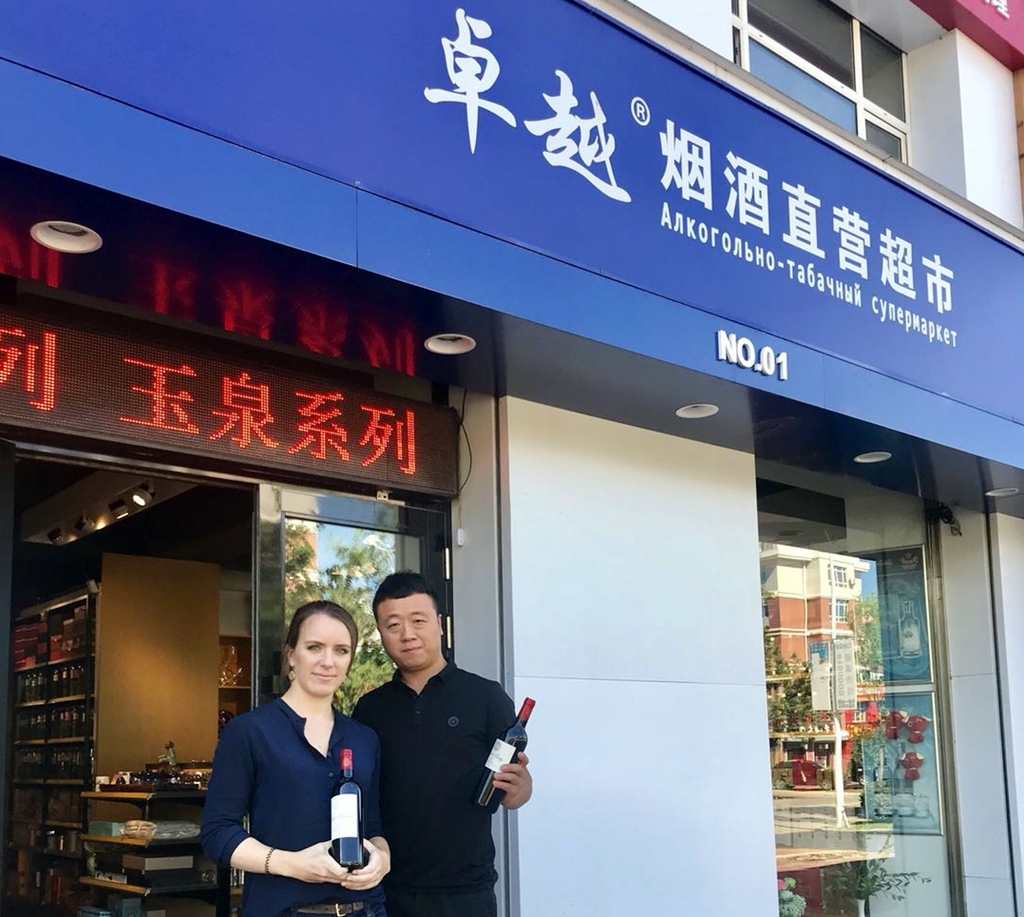
How did you end up in Heihe?
I met my client at a trade fair in Harbin in 2015. He had a store in Heihe, a pretty nice one, and he did well and upgraded it. His portfolio includes my wine, tons of cheap French wine, fake Lafite, and Penfolds. He sells 700 bottles of my stuff per year.
Lots of consumers show up, buy wine and go to restaurants, and he sells directly to restaurants, too. He also sells baijiu and beer. Wine is the smallest part of his business. He has maps of each city district with their performance. He took me to a Michael Jackson-themed restaurant when I visited.
That’s just one of many cities where you are active.
We have 60 distributors and most are in different cities. The only places we are not represented are Tibet, Gansu, Ningxia and Qinghai.
And you met your Heihe client at a wine trade fair?
The Harbin wine fair. I was the only foreigner there.
I don’t do big fairs like Prowine [in Shanghai] or Topwin [in Beijing]. Prowine is 4,000 Euros [31,000 RMB] to get a booth for three days and I have no idea who I am going to meet. I went once and mostly met Chinese students learning about wine.
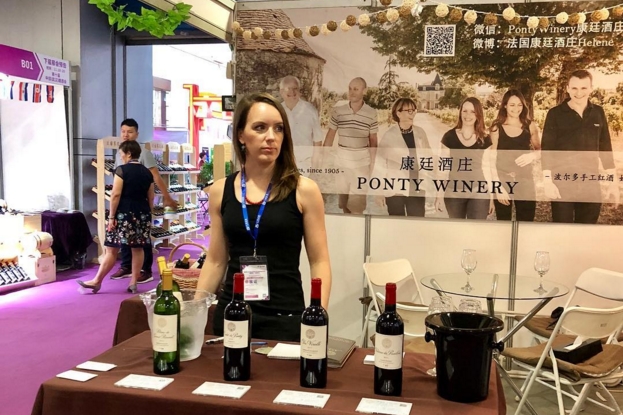
If I go to a local wine fair, I spend 5,000 RMB for three days and my success rate for finding a local distributor is 100 percent. If I don’t have a distributor in Wuhan, I go to the Wuhan Wine Fair (above) to find one.
Some of these fairs are not professional. Sometimes there is no ice or people smoke or people spit on the floor near my booth. At one fair in Hebei, I really felt sick after three days because the smoke was so thick. But I can find distributors. I sometimes send my team and they still make the connections.
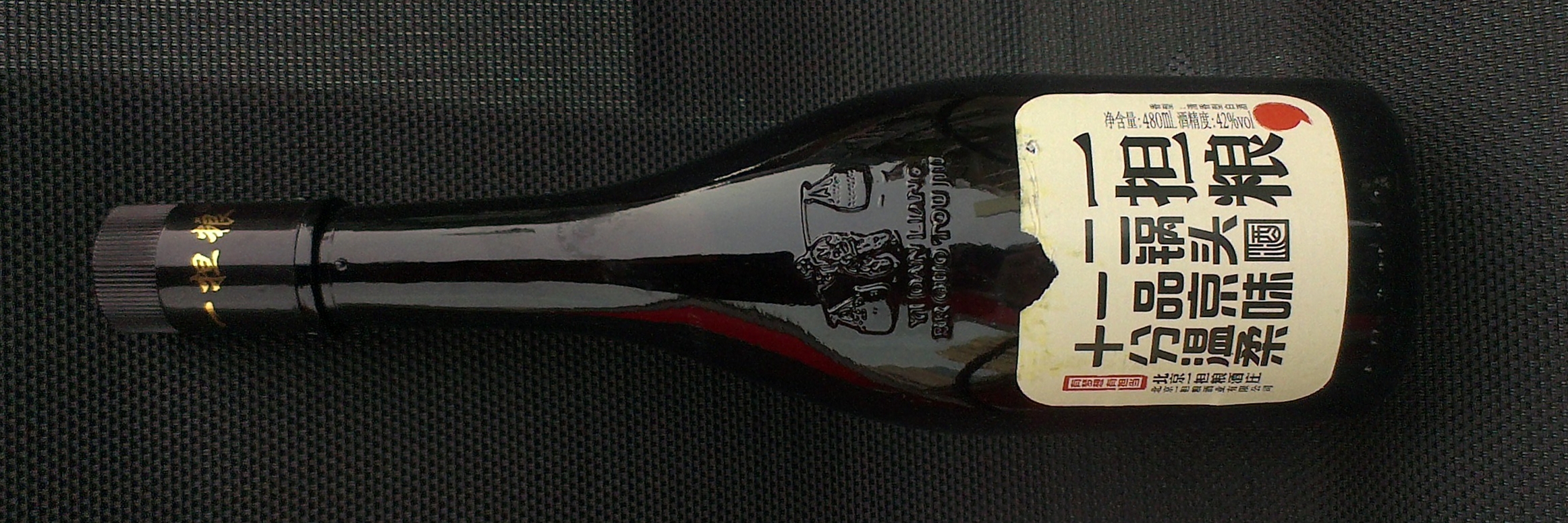
Baijiu 1: Erguotou is a much-loved baijiu style in Beijing and Yidanliang and inexpensive option. Ponty’s evaluation: “Marinated fruit. It’s very sweet and a bit sour. It’s like a tart candy in France called Arlequin.”
Online Sales, Offline Ganbei
Boyce: How do smaller cities like Heihe compare to so-called tier-one places like Beijing, Shanghai and Shenzhen, especially as online retail makes wine more accessible?
Ponty: We are mostly in smaller cities and in traditional channels. Online retail has not really changed things so much for us. Some of our clients see a threat from the prices, but a lot of people like buying from someone they know, and our clients get customers through introductions from other customers.
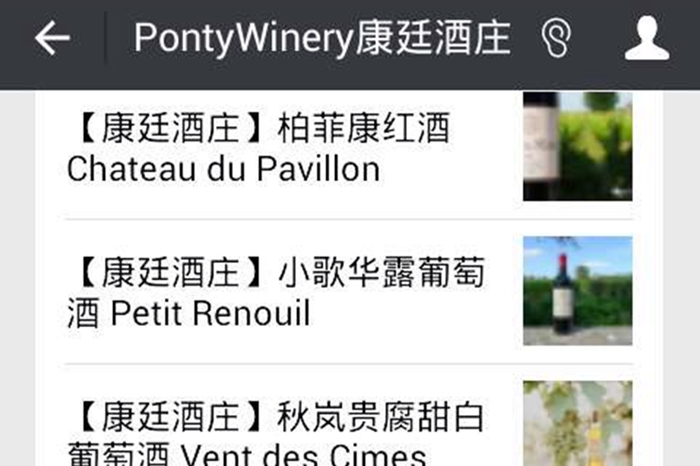
How about your own experience, with the WeChat store you launched?
Our online store is more of an experiment. Why did we do it? Because we were only wholesale and I got a bit frustrated with our distributors late last year. I feel the market is changing and they are not responding.
[For distributors] it’s not just about relationships anymore, about a few key companies where you know the purchasing guy and there is no discussion of prices. Those companies are more careful now. You have to sell to normal consumers, and they want to know about the wine and why it’s good. You have to sell the wine, not just make friends.
How did that view go over?
Their attitude was that I’m a foreigner; that I don’t understand China. I was frustrated and decided to target Beijing with an online store and do things how we think they should be done. So far it’s pretty good. Not a huge number of consumers but they return. It’s teaching us how to do e-commerce and reach younger consumers, to see what kids [aged 25 to 40] are looking for in Beijing.
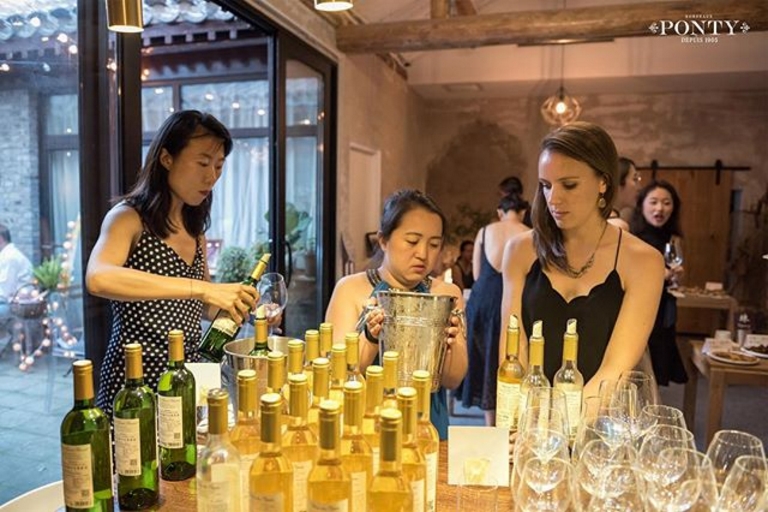
Does that age group have buying power?
Yes, lots of consumers aged 25 to 35 have money.
I also did this for my mental health. I love doing events for them. They’re curious, they like wine and they ask great questions.
Our last event (above) was a launch for our new sweet white wine Vent des Cimes. Since we have never done a sweet white wine before, we wanted to understand how people like to drink it, and let people experience food pairings. We created three food stations around major flavors — ”salty, sweet and spicy — ”with a mix of classic French food, like blue cheese, and classic Chinese food, mostly Sichuanese.
It’s different from an event in [a city like] Hefei where it’s just about downing wine. I have a good time there, and people are super nice, but [people at the Beijing events] care about the wine and story and what we are trying to do. These events are good preparation: if they are happening in Beijing and Shanghai, they will eventually come to other cities.
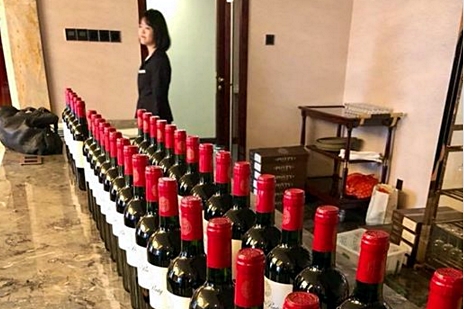
Speaking of downing wine, what percent of Ponty wine that you drink is sipped rather than ganbei’d?
Ninety-five percent is ganbei, with some differences. The ganbei might be to fill a glass a little or you might not have to drink it all. Where things go wrong is when you have to down a full glass — and I do it.
The most important thing is that [people at dinners] don’t care at all about sipping or talking about the wine style, like the aroma or flavor. They want to know if it tastes good; if they like it. They might say it’s lighter or stronger, but they don’t talk about the specific characteristics.
I usually explain a little about wine culture in France, but they are not interested, because in China you drink to get drunk, and if you are drunk it means you are happy. If you are at a dinner and not doing that, it means you are not having a good time. I have no problem with that.
Also, if you are drunk, you have nothing to hide, you are a good business partner. People are not interested in changing that. If you drink wine in a different way, it is seen as not very friendly.
And that’s very different from France.
When they come to France, they start to toast and ganbei my parents. I tell them we don’t do it like that. They realize the way we eat in France is more formal but the way we drink is less formal, the opposite of China. They end up drinking a lot less because they are drinking what they want.

Baijiu 2: Shanxi’s sorghum-based Fenjiu ranks among China’s top brands. Says Ponty: “Earthy, rich but balanced, warming. Something you could sit by the fire and sip.”
Red vs White
The wine trade outside China is convinced consumers here are addicted to red wine but your experiences suggest otherwise, right?
When we do consumer events, our whites are super popular. The problem is the distributors. A few years ago, some of the guys were saying they won’t drink white wine because it’s only for women. Now they don’t say that so much, now the issue is they don’t know much about white wine.
They don’t know how to prepare or serve them. They don’t have it chilled for delivery, or even know to do that, and before every tasting, I have to check to see if the white wines are chilled. They can just open red wine but white wine is a much more troublesome product for them.
I always tell them in France, it’s seafood with white wine. It’s the most logical advice I can give, even though I know some fish sauces in China might work with red. I just want to create a way for them to understand white wine.
You say consumers love the white wines at tastings. Does that translate into sales?
From our WeChat and Financial Times stores, I think white wines are the best seller, although we have only had the FT store two months and those numbers might be influenced by the summer.
I think it’s harder for people to find a good white wine so, if they do, they keep buying it. And our white wine is good for Chinese consumers. It’s not too dry, with a little residual sugar, and fruity, fresh and round.
And now you have introduced a sweet white Semillon. Why do that now and who is target?
We want to keep growing and need to add to our portfolio. Two years ago, I asked our customers if they wanted a rose, sparkling or sweet wine. Our customers in China overwhelmingly said sweet wine. If not for them, we probably would have done a rose.
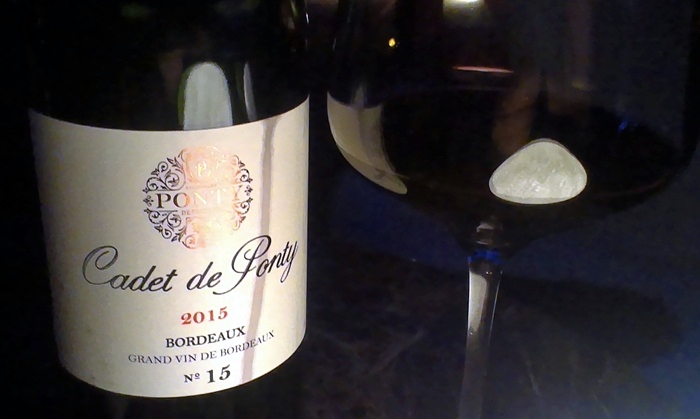
When we do a new wine, we want to do something better than what’s available. For cheaper Bordeaux, there is so much crap. We added an entry-level Bordeaux (above) last year because we thought we could do better.
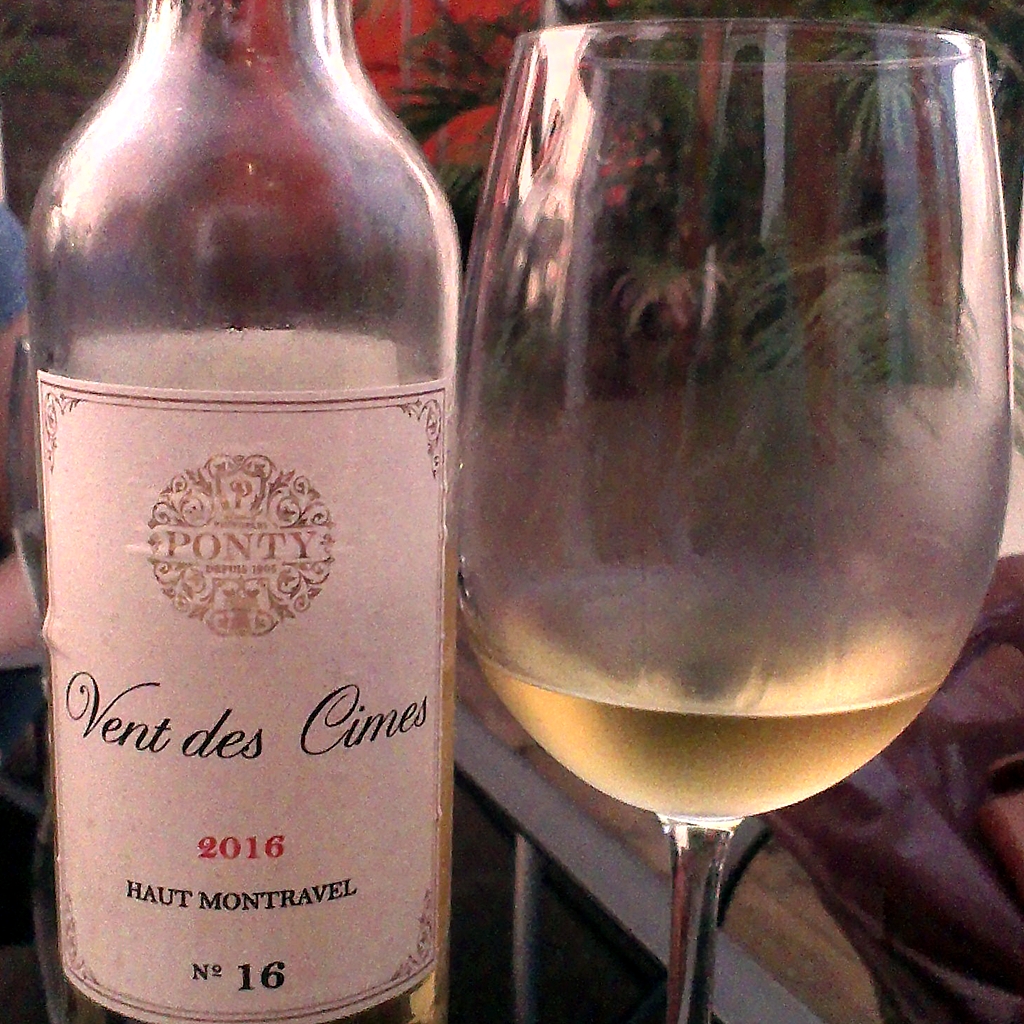
It’s the same with sweet wine (above). Even in Bordeaux, we are not that happy with the local wines. They are too sweet and not fresh.
I wanted a sweet wine with lots of freshness that people can drink throughout the night. A big target is smaller cities. Our distributors are mainly 35- to 55-year-old Chinese guys who have their own company or a job where they have to entertain a lot. Often their wives come to dinners and don’t drink baijiu and maybe not red wine. But they love sweet white wine. Ladies in smaller cities who don’t drink a lot, and even say they are allergic to alcohol, like this wine.
There are also often people in the younger crowd that drink wine, who like sweet wine.

Baijiu 3: Yimuquan is a mixed-aroma baijiu from Baoding, just outside Beijing. Says Ponty: “Fresh, especially after the richness of fenjiu. A little sharper, a little floral. Maybe good with some spicy food.”
Individuality and Exclusivity
Boyce: France is the top source of imported wine here and Bordeaux the most biggest part of that, but it’s a crazy space, with pricey elite labels at one end and super cheap aspirational ones at the other. With the sheer number of brands, and the many fakes, where does your small Bordeaux winery fit?
Ponty: Our wine is on one client’s shelf next to a Bordeaux brand called Wenke Lafei. They think if it says Lafei, it’s Lafite, and I have to explain that’s just a Chinese name. They were selling it for more than my wine. What can we do? We try hard to explain the situation but they put the stuff on the shelf because they don’t know better.
I give our clients a few key messages about our brand. I explain how it is hand-crafted, how we harvest by hand, how my father does everything in the cellar based on experience. People like that.
Another thing is our relationship with distributors. They can work directly with us and we do all the branding. They know if they work with me, they can send me photos of a wine or bottle, and ask if I think it is good or fake. They trust me. We are present in China and they can use that support. Almost no one else is doing this.
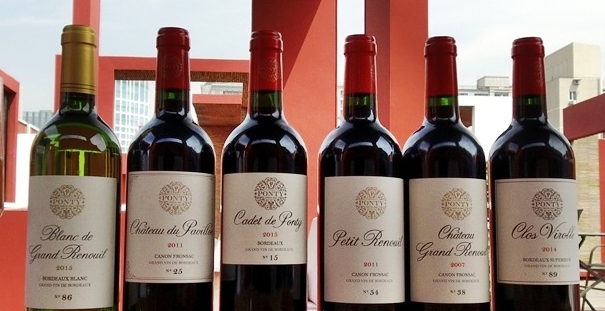
Distributors love exclusivity as it provides flexibility for pricing. How do you handle it?
We give exclusivity by city or province. This is so important because most clients are completely paranoid about other people selling our wine in the same city.
We had a guy in one city who bought from us once and wanted exclusivity. I told him what he needed to reach targets and he said he couldn’t do it, but he still wanted exclusivity, with no targets and with penalties if we used other distributors. He became very unhappy because I told other people our prices and he felt that was unfair. It’s a very Chinese point of view. He wants exclusivity but he can’t meet the targets. I want to see growth.
In general, we give exclusivity to most distributors but sometimes I have to say, you have a city of 10 million people, I am pretty sure it can handle more than one distributor. If your service is good, people will stick with you. The problem is many distributors don’t have good service.

Baijiu 4: Jiangxianghe is a strong aroma baijiu from Anhui. Says Ponty: You know in wine when they say the attack is strong? The attack is strong. It’s like a mustard that’s too… mustard-y.”
Regrets, Benefits, More
Boyce: OK, I’m feeling this baijiu. Let’s finish with a power round. Short questions, short answers. Number one: your biggest regret about doing the wine business in China?
Ponty: Biggest regret? The toll on my health. I’ve had pneumonia and three bacterial infections from the food. I’m pretty sure my lungs are not happy. Plus, my liver.
Most unexpected benefit?
Getting compliments all the time. It’s a huge boost to the ego. Not only do people tell me I’m beautiful but my nose comes up all the time. Everywhere I go, I get compliments on my nose. I have an awesome nose? I had no idea!
Best Chinese food and Ponty wine pairing?
Our Pavilion and roast lamb with a little bit of cumin.
Is Chinese getting as good as French, yes or no?
No.
Care to elaborate?
It might someday but we’ve been making wine for thousands of years. It’s not going to happen here in 20 years.
Favorite smaller city where you’ve done business?
Xiamen. The air is pretty good, the climate is nice, it’s close to the water and gets a breeze, and the seafood is great. It’s not too big and the airport is close, so it’s easy to get in and out. Also, they drink a ton of wine (above) but also care.
And least favorite?
Changsha. It’s very gray and polluted, The city is cold and not pretty and the drinking culture is intense. But the Hunan countryside is pretty
Speaking of intense, how many bottles of wine can you drink?
I always get that question! What does it mean? While drinking quickly? Slowly? Over the course of a day? With food? No food?
After six years, your overall take on the scene?
I’m still not finding anything exciting to drink from the wine trade in general. You go to France and they have cool wineries doing great stuff, and Australia, too, but you don’t find that in China. It’s all the standard stuff.
Name a restaurant you can go to and say, “That’s a nice wine list, there is so much to drink, I don’t know what to order.” Or a wine shop where you can say “that’s cool stuff.”
I have some clients now who care and are getting some wine like that but most of it is, been there, done that, had it before.

Baijiu 5: Taizi from New Zealand. Ponty: Says Ponty: “This is 58% alcohol but it’s more integrated, it’s smoother and richer.”
Get more info about Ponty at the winery’s website here or on WeChat with the id PontyWinery. This Q&A was done at Q Bar.

Grape Wall has no sponsors of advertisers: if you find the content and projects like World Marselan Day worthwhile, please help cover the costs via PayPal, WeChat or Alipay.
Sign up for the free Grape Wall newsletter here. Follow Grape Wall on LinkedIn, Instagram, Facebook and Twitter. And contact Grape Wall via grapewallofchina (at) gmail.com.

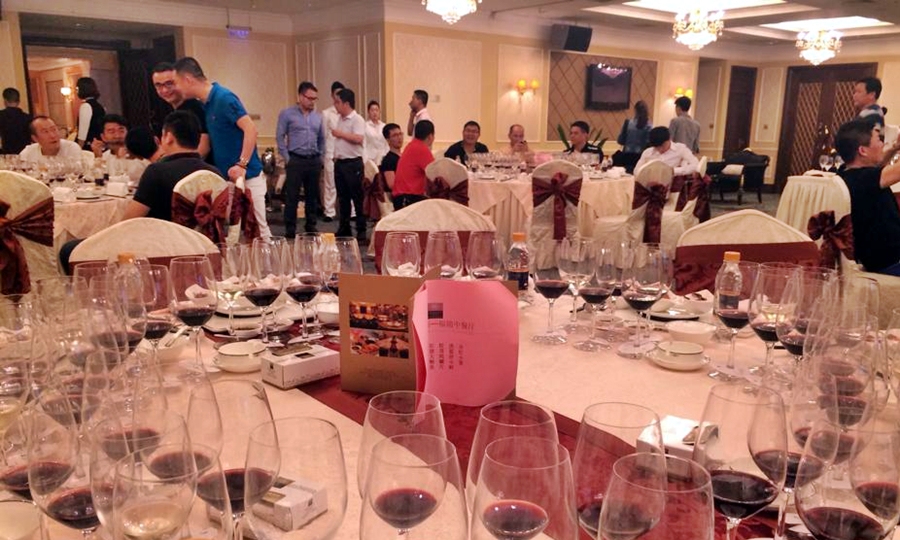
Leave a Reply
You must be logged in to post a comment.